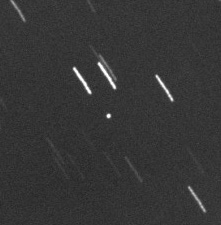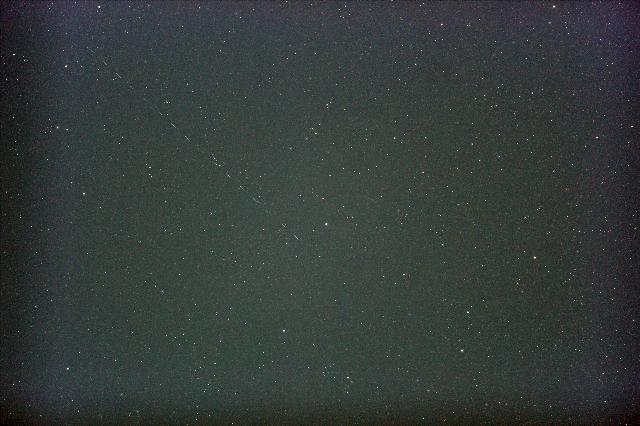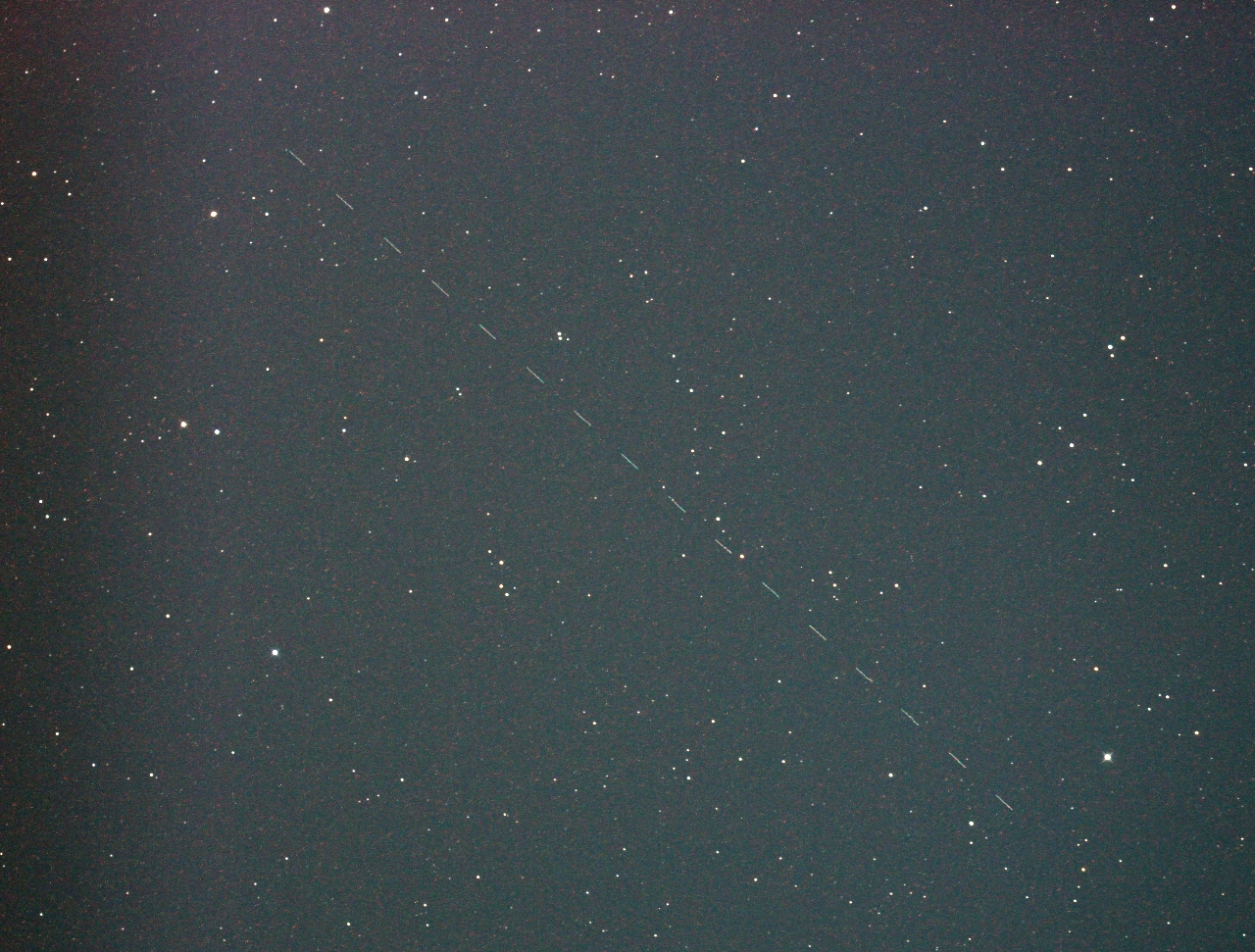



地球接近天体2015TB145
2015/10/31T23:11:29〜23:17:45までの8秒間露光16枚を合成
露光時間:8秒*16=2分08秒 ISO3200 長時間ノイズリダクションをオン
ε160/530mm + LPS-P2 + 60D / EM200Temma2
StellaImage4と6.5で合成、レベル補正とリサイズ
|
* NEO 2015TB145 *
http://www.skyandtelescope.com/astronomy-news/observing-news/2015-tb145-asteroid-or-dead-comet-10312015/ 2015 TB145 ? Rogue Asteroid or Dead Comet? By: Kelly Beatty | October 31, 2015 Astronomers can't decide whether the sizable object known as 2015 TB145, which is cruising past Earth today, is a renegade from the asteroid belt or a short-period comet with nothing left to give. Ever since its discovery three weeks ago with the Pan-STARRS 1 survey telescope, the object now designated 2015 TB145 has been something of a paradox to astronomers. Telescopically it remained just a starlike point and thus probably an asteroid that got shoved onto an orbit that carries it in Earth's general vicinity. But that 3.1-year-long orbit is extremely long and narrow, with an eccentricity of 0.86 (0.00 is a perfect circle). Dynamicists see that as more comet-like. Radar rotation of 2015 TB145 A sequence of six range-Doppler radar maps, acquired with the 300-meter Arecibo Radio Telescope in Puerto Rico, reveals that the sppoky-looking near-Earth object 2015 TB145 is roughly 600 meters across ? nearly twice as large as expected based on telescopic imaging. The smallest details are about 7? meters (25 feet) across. SRI Intl. / Ana G. Mendez Univ. System / USRA Now, thanks to new observations, 2015 TB145 is looking more and more like a dead comet. Yesterday planetary specialists at the Arecibo Observatory in Puerto Rico probed the object with powerful radar pulses, and the resulting echos show that it's more or less round, rotates every 5 hours, and has a diameter of about 600 meters (2,000 feet). That's considerably larger than the initial estimates (300 to 400 m), and it means that 2015 TB145 is relatively big as near-Earth objects go. The larger-than-expected size makes sense because this body turns out to be nearly black. By combining its visible-light brightness with scans made with NASA's Infrared Telescope Facility (IRTF) on Mauna Kea, Hawai'i, researchers now estimate that the surface reflects only about 6% of the sunlight that strikes it. Most comets have a reflectivity in the range of 3% to 5%, but asteroids are usually considerably higher, around 15% to 20%. Arecibo's radar probings show that 2015 TB145 has a kind of spooky appearance, reminiscent of a human skull. Two low-reflectivity "eye sockets" might turn out to be craters. (Technically, these aren't images in the usual sense; the radar echoes are instead two-dimensional maps that plot the pulses' round-trip light time versus the Doppler shift caused by rotation. Bright and dark areas correspond to radar reflectivity, not necessarily surface brightness.) Other radar studies are planned throughout the weekend using the big Arecibo dish along with those at NASA's Goldstone facility in the Mojave Desert, the Green Bank Telescope in West Virginia, and Haystack Observatory in Massachusetts. ******* A Halloween Vigil for 2015 TB145 Meanwhile, astronomers around the world have been tracking this object as it zips past Earth at a relatively fast 35 km (22 miles) per second, a consequence of its elongated orbit. Dynamicists at the Jet Propulsion Laboratory calculate that when 2015 TB145 comes closest, at 17:01 Universal Time (1:01 p.m. Eastern Daylight Time), it will be 480,400 km (298,500 miles) away, about 30% farther than the Moon. *************** Telescopic image of 2015 TB145 Here's how 2015 TB145 looked at 17:46 Universal Time on October 30th. Background stars trailed during the 2-minute exposure, recorded with a remotely operated 17-inch PlaneWave telescope and SBIG STL-6303E CCD camera. The field of view is about 8 arcminutes square. Gianluca Masi / Virtual Telescope Project ************** Although making a rather distant pass, the object will brighten to magnitude 10.1. When closest to us, it is in Ursa Major and passes just ?° from 2nd-magnitude Phad in the Big Dipper's bowl. But at that time it's daylight all across North America. So for most North Americans the best opportunity to catch a glimpse of this interloper came early this morning, when it was near the Orion-Taurus border. Yes, I dutifully got up at 5 a.m. to track it down by eye. It was a struggle: a fat gibbous Moon, less than 10° away, flooded the sky with scattered light. But thanks to my Celestron 9&frc14;-inch telescope and a careful alignment, I was able to navigate directly to the object's location with relative ease. Faint but obvious, it moved slowly among the background stars. Those of you in far-northern locations or in Europe or Asia can use the chart below as a guide for where to find 2015 TB145 for yourself. Just remember that Sky & Telescope's chart shows the apparent path as seen from Earth's center, and the object's proximity to Earth will create a positional shift in the sky due to parallax of ?° or more. Moreover, the position will change by more than a lunar diameter every 3 minutes when closest to Earth. So if you're trying to observe 2015 TB145, you'll need to get celestial coordinates specific to your location. For more information, check out this JPL press release and this Virtual Telescope webcast moderated earlier today by Gianluca Masi. Path of asteroid 2015 TB145 **** This chart shows the path of 2015 TB145 as it sweeps past Earth at 35 km per second. During this 20-hour-long period the object's magnitude varies from 10.1 to 12.2, and its proximity to Earth will create a parallax shift of ?° or more. So you won't be able to point your telescope based on this track; instead, you will need to consult another source to generate positions specific to your location (see text). Click here for a full-size version of this chart or click here for a black-on-white version. Both are sized for tabloid (11-by-17-inch) paper. S&T: Gregg Dinderman ***** - See more at: http://www.skyandtelescope.com/astronomy-news/observing-news/2015-tb145-asteroid-or-dead-comet-10312015/#sthash.7Zh4YVLn.dpuf |
2015年10月31日



